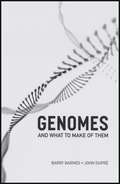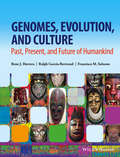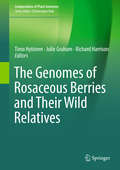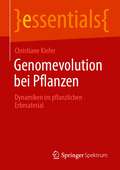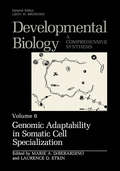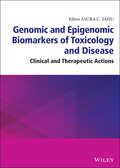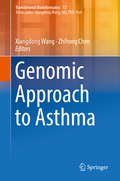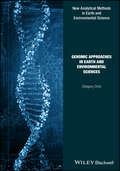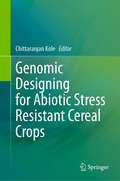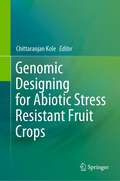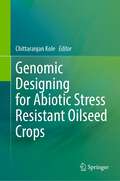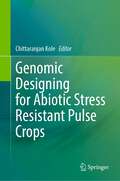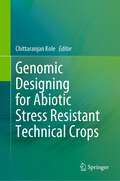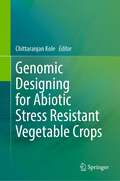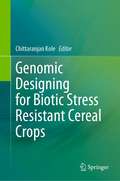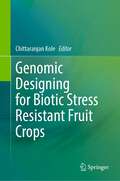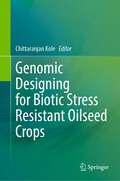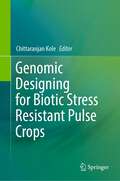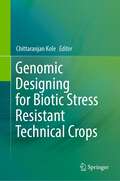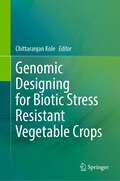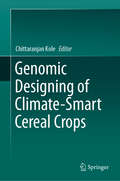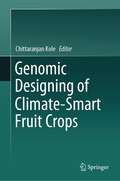- Table View
- List View
Genomes and What to Make of Them
by Barry Barnes John DupréThe announcement in 2003 that the Human Genome Project had completed its map of the entire human genome was heralded as a stunning scientific breakthrough: our first full picture of the basic building blocks of human life. Since then, boasts about the benefits—and warnings of the dangers—of genomics have remained front-page news, with everyone agreeing that genomics has the potential to radically alter life as we know it. For the nonscientist, the claims and counterclaims are dizzying—what does it really mean to understand the genome? Barry Barnes and John Dupré offer an answer to that question and much more in Genomes and What to Make of Them, a clear and lively account of the genomic revolution and its promise. The book opens with a brief history of the science of genetics and genomics, from Mendel to Watson and Crick and all the way up to Craig Venter; from there the authors delve into the use of genomics in determining evolutionary paths—and what it can tell us, for example, about how far we really have come from our ape ancestors. Barnes and Dupré then consider both the power and risks of genetics, from the economic potential of plant genomes to overblown claims that certain human genes can be directly tied to such traits as intelligence or homosexuality. Ultimately, the authors argue, we are now living with a new knowledge as powerful in its way as nuclear physics, and the stark choices that face us—between biological warfare and gene therapy, a new eugenics or a new agricultural revolution—will demand the full engagement of both scientists and citizens. Written in straightforward language but without denying the complexity of the issues, Genomes and What to Make of Them is both an up-to-date primer and a blueprint for the future.
Genomes, Evolution, and Culture: Past, Present, and Future of Humankind
by Rene J. Herrera Ralph Garcia-Bertrand Francisco M. SalzanoThis book combines recent information and discoveries in the field of human molecular biology and human molecular evolution. It provides an interdisciplinary approach drawing together data from various diverse disciplines to address both the more classical anthropological content and the current more contemporary molecular focus of courses. Chapters include a history of human evolutionary genetics; the human genome structure and function; population structure and variability; gene and genomic dynamics; culture; health and disease; bioethics; future.
Genomes, Evolution, and Culture: Past, Present, and Future of Humankind
by Rene J. Herrera Ralph Garcia-Bertrand Francisco M. SalzanoThis book combines recent information and discoveries in the field of human molecular biology and human molecular evolution. It provides an interdisciplinary approach drawing together data from various diverse disciplines to address both the more classical anthropological content and the current more contemporary molecular focus of courses. Chapters include a history of human evolutionary genetics; the human genome structure and function; population structure and variability; gene and genomic dynamics; culture; health and disease; bioethics; future.
The Genomes of Rosaceous Berries and Their Wild Relatives (Compendium of Plant Genomes)
by Timo Hytönen Julie Graham Richard HarrisonThis book collates the most up to date information on Fragaria, and Rubus genomes. It focuses on the latest advances in the model system Fragaria vesca, along with the allied advances in economically important crops. Covering both basic and applied aspects of crop genomics, it illustrates strategies and resources for the study and utilization of genome sequences and aligned functional genomics resources.Rosaceous berries are collectively an increasingly important set of high-value global crops, with a trade value of over £2 billion dollars per annum. The rosaceous berries strawberry, raspberry and blackberry share some common features at the genome scale, namely a range of ploidy levels in each genus and high levels of heterozygosity (and associated inbreeding depression) due to self-incompatibility systems, dioecy, or multispecies hybridization events. Taken together, although the genomes are relatively compact, these biological features lead to significant challenges in the assembly and analysis of berry genomes, which until very recently have hampered the progress of genome-level studies.The genome of the woodland strawberry, Fragaria vesca, a self-compatible species with a homozygous genome was first sequenced in 2011 and has served as a foundation for most genomics work in Fragaria and to some extent Rubus. Since that time, building upon this resource, there have been significant advances in the development of genome sequences for related crop species. This, coupled with the revolution in affordable sequencing technology, has led to a suite of genomics studies on Fragaria and more recently Rubus, which undoubtedly aid crop breeding and production in future years.
Genomevolution bei Pflanzen: Dynamiken im pflanzlichen Erbmaterial (essentials)
by Christiane KieferDie Zellen eines jeden Lebewesens enthalten die Erbinformation in Form von DNA, auch Genom genannt, welche zu einem Großteil Aussehen und Funktion eines Organismus bestimmt. Auch bei Pflanzen ist das nicht anders. Die Erbinformation ist nicht statisch, sondern verändert sich mit großer Dynamik. In diesem essential erhalten Sie einen breiten Überblick über die Prozesse, welche das Pflanzengenom im Laufe der Evolution verändern. Was ist Polyploidie und warum kann sie die Entstehung von Genen mit neuen Funktionen fördern? Warum sind manche Pflanzengenome riesig und andere dagegen winzig, obwohl sie nahezu gleich viele Gene enthalten? Und welche Einblicke gewährt uns das Zeitalter genomischer Studien in die Veränderlichkeit und Flexibilität der Erbsubstanz?
Genomic Adaptability in Somatic Cell Specialization: Genomic Adaptability In Somatic Cell Specialization (Developmental Biology #6)
by Marie A. DiBerardino Laurence D. EtkinI am pleased to include this book as Volume 6 of Developmental Biology: A Comprehensive Synthesis. It has been edited by two of the foremost investiga tors in the study of genomic adaptability. lowe a special debt of gratitude to Dr. Marie A. DiBerardino, who developed the concept of the volume. Dr. DiBerar dino is also a very active member of the editorial board for this series. Much of the success of this series is due to her valuable advice. This series was established to create comprehensive treatises on specific topics in developmental biology. Such volumes serve a useful role in develop mental biology, since it is a very diverse field that receives contributions from a wide variety of disciplines. This series is a meeting ground for the various practitioners of this science, facilitating an integration of heterogeneous infor mation on specific topics. Each volume is intended to provide the conceptual basis for a comprehen sive understanding of its topic as well as analysis of the key experiments upon which that understanding is based. The specialist in any aspect of developmen tal biology should understand the experimental background of the field and be able to place that body of information in context to ascertain where additional research would be fruitful. At that point, the creative process generates new experiments. This series is intended to be a vital link in that process of learning and discovery.
Genomic and Epigenomic Biomarkers of Toxicology and Disease: Clinical and Therapeutic Actions
by Saura C. SahuGenomic and Epigenomic Biomarkers of Toxicology and Disease The latest developments in biomarker research applicable to toxicology and medicine Research on genomic and epigenomic biomarkers is developing rapidly with cutting-edge studies scattered throughout the academic literature, making the status of ongoing scientific activity in this area difficult to ascertain. Genomic and Epigenomic Biomarkers of Toxicology and Disease: Clinical and Therapeutic Actions delivers a comprehensive and authoritative compilation of up-to-date developments in the application of genomic and epigenomic biomarkers to toxicology, disease prevention, cancer detection, therapeutics, gene therapy, and other areas. With contributions from a collection of internationally recognized investigators, this edited volume offers unique insights into current trends and future directions of research in the discussed areas. Combining state-of-the-art information on genomic and epigenomic biomarkers from a range of specialists from around the world, this monograph includes: A thorough introduction to microRNAs as non-invasive biomarkers of toxicity and chemical hazard Comprehensive explorations of extracellular vesicle-associated miRNAs as toxic biomarkers, as well as transcriptomic applications in toxicology and medicine Practical discussions of circulating miRNAs as biomarkers of metal exposure, as well as microRNAs biomarkers of malignant mesothelioma In-depth examinations of the role of noncoding RNAs in innate immune responses perturbed by environmental arsenic with a focus on microRNAs Perfect for researchers, toxicologists, risk assessors, and regulators, Genomic and Epigenomic Biomarkers of Toxicology and Disease: Clinical and Therapeutic Actions will also earn a place in the libraries of graduate students with an interest in biomarkers, toxicology, agriculture, or the environment.
Genomic and Epigenomic Biomarkers of Toxicology and Disease: Clinical and Therapeutic Actions
by Saura C. SahuGenomic and Epigenomic Biomarkers of Toxicology and Disease The latest developments in biomarker research applicable to toxicology and medicine Research on genomic and epigenomic biomarkers is developing rapidly with cutting-edge studies scattered throughout the academic literature, making the status of ongoing scientific activity in this area difficult to ascertain. Genomic and Epigenomic Biomarkers of Toxicology and Disease: Clinical and Therapeutic Actions delivers a comprehensive and authoritative compilation of up-to-date developments in the application of genomic and epigenomic biomarkers to toxicology, disease prevention, cancer detection, therapeutics, gene therapy, and other areas. With contributions from a collection of internationally recognized investigators, this edited volume offers unique insights into current trends and future directions of research in the discussed areas. Combining state-of-the-art information on genomic and epigenomic biomarkers from a range of specialists from around the world, this monograph includes: A thorough introduction to microRNAs as non-invasive biomarkers of toxicity and chemical hazard Comprehensive explorations of extracellular vesicle-associated miRNAs as toxic biomarkers, as well as transcriptomic applications in toxicology and medicine Practical discussions of circulating miRNAs as biomarkers of metal exposure, as well as microRNAs biomarkers of malignant mesothelioma In-depth examinations of the role of noncoding RNAs in innate immune responses perturbed by environmental arsenic with a focus on microRNAs Perfect for researchers, toxicologists, risk assessors, and regulators, Genomic and Epigenomic Biomarkers of Toxicology and Disease: Clinical and Therapeutic Actions will also earn a place in the libraries of graduate students with an interest in biomarkers, toxicology, agriculture, or the environment.
Genomic Approach to Asthma (Translational Bioinformatics #12)
by Xiangdong Wang Zhihong ChenThis volume in the series, Translational Bioinformatics, provides an up-to-date overview of genomic approaches to asthma. By applying unbiased “-omics” combined with disease-focused and hypothesis-driven approaches, it enhances readers’ understanding of the asthma endotype. Furthermore, it elucidates how progress in -omics research, such as “genomic,” “transcriptomic,” “protomic,” and “metabolomic,” is applied in asthma, and reports on the related series of important breakthroughs in asthma development, classification, prevention and drug sensitivity. Also covering systems biology knowledge and methodologies, computational models and biostatistical methods to analyze big data, this book provides a valuable resource for scientists and researchers in the field of asthma and respiratory diseases.
Genomic Approaches in Earth and Environmental Sciences (Analytical Methods in Earth and Environmental Science)
by Gregory DickThe first comprehensive synthesis of genomic techniques in earth sciences The past 15 years have witnessed an explosion of DNA sequencing technologies that provide unprecedented insights into biology. Although this technological revolution has been driven by the biomedical sciences, it also offers extraordinary opportunities in the earth and environmental sciences. In particular, the application of "omics" methods (genomics, transcriptomics, proteomics) directly to environmental samples offers exciting new vistas of complex microbial communities and their roles in environmental and geochemical processes. This unique book fills the gap where there exists a lack of resources and infrastructure to educate and train geoscientists about the opportunities, approaches, and analytical methods available in the application of omic technologies to problems in the geosciences. Genomic Approaches in Earth and Environmental Sciences begins by covering the role of microorganisms in earth and environmental processes. It then goes on to discuss how omics approaches provide new windows into geobiological processes. It delves into the DNA sequencing revolution and the impact that genomics has made on the geosciences. The book then discusses the methods used in the field, beginning with an overview of current technologies. After that it offers in-depth coverage of single cell genomics, metagenomics, metatranscriptomics, metaproteomics, and functional approaches, before finishing up with an outlook on the future of the field. The very first synthesis of an important new family of techniques Shows strengths and limitations (both practical and theoretical) of the techniques Deals with both theoretical and laboratory basics Shows use of techniques in a variety of applications, including various aspects of environmental science, geobiology, and evolution Genomic Approaches in Earth and Environmental Sciences is a welcome addition to the library of all earth and environmental scientists and students working within a wide range of subdisciplines.
Genomic Approaches in Earth and Environmental Sciences (Analytical Methods in Earth and Environmental Science)
by Gregory DickThe first comprehensive synthesis of genomic techniques in earth sciences The past 15 years have witnessed an explosion of DNA sequencing technologies that provide unprecedented insights into biology. Although this technological revolution has been driven by the biomedical sciences, it also offers extraordinary opportunities in the earth and environmental sciences. In particular, the application of "omics" methods (genomics, transcriptomics, proteomics) directly to environmental samples offers exciting new vistas of complex microbial communities and their roles in environmental and geochemical processes. This unique book fills the gap where there exists a lack of resources and infrastructure to educate and train geoscientists about the opportunities, approaches, and analytical methods available in the application of omic technologies to problems in the geosciences. Genomic Approaches in Earth and Environmental Sciences begins by covering the role of microorganisms in earth and environmental processes. It then goes on to discuss how omics approaches provide new windows into geobiological processes. It delves into the DNA sequencing revolution and the impact that genomics has made on the geosciences. The book then discusses the methods used in the field, beginning with an overview of current technologies. After that it offers in-depth coverage of single cell genomics, metagenomics, metatranscriptomics, metaproteomics, and functional approaches, before finishing up with an outlook on the future of the field. The very first synthesis of an important new family of techniques Shows strengths and limitations (both practical and theoretical) of the techniques Deals with both theoretical and laboratory basics Shows use of techniques in a variety of applications, including various aspects of environmental science, geobiology, and evolution Genomic Approaches in Earth and Environmental Sciences is a welcome addition to the library of all earth and environmental scientists and students working within a wide range of subdisciplines.
Genomic Designing for Abiotic Stress Resistant Cereal Crops
by Chittaranjan KoleThis book presents abiotic stresses that cause crop damage in the range of 6-20%. Understanding the interaction of crop plants to the abiotic stresses caused by heat, cold, drought, flooding, submergence, salinity, acidity, etc., is important to develop resistant crop varieties. Knowledge on the advanced genetic and genomic crop improvement strategies including molecular breeding, transgenics, genomic-assisted breeding, and the recently emerging genome editing for developing resistant varieties in cereal crops is imperative for addressing FPNEE (food, health, nutrition, energy, and environment) security. Whole genome sequencing of these crops followed by genotyping-by-sequencing has facilitated precise information about the genes conferring resistance useful for gene discovery, allele mining, and shuttle breeding which in turn opened up the scope for 'designing' crop genomes with resistance to abiotic stresses. The nine chapters each dedicated to a cereal crop in this volume are deliberate on different types of abiotic stresses and their effects on and interaction with crop plants; enumerate on the available genetic diversity with regard to abiotic stress resistance among available cultivars; illuminate on the potential gene pools for utilization in interspecific gene transfer; are brief on the classical genetics of stress resistance and traditional breeding for transferring them to their cultivated counterparts; elucidate on the success stories of genetic engineering for developing abiotic stress-resistant crop varieties; discuss on molecular mapping of genes and QTLs underlying stress resistance and their marker-assisted introgression into elite varieties; enunciate on different emerging genomics-aided techniques including genomic selection, allele mining, gene discovery, and gene pyramiding for developing adaptive crop varieties with higher quantity and quality, and also elaborate some case studies on genome editing focusing on specific genes for generating abiotic stress-resistant crops.
Genomic Designing for Abiotic Stress Resistant Fruit Crops
by Chittaranjan KoleThis book presents deliberations on molecular and genomic mechanisms underlying the interactions of crop plants to the abiotic stresses caused by heat, cold, drought, flooding, submergence, salinity, acidity, etc., important to develop resistant crop varieties. Knowledge on the advanced genetic and genomic crop improvement strategies including molecular breeding, transgenics, genomic-assisted breeding, and the recently emerging genome editing for developing resistant varieties in fruit crops is imperative for addressing FHNEE (food, health, nutrition, energy, and environment) security. Whole genome sequencing in many of these crops followed by genotyping-by-sequencing has provided precise information regarding the genes conferring resistance useful for gene discovery, allele mining, and shuttle breeding which in turn opened up the scope for 'designing' crop genomes with resistance to abiotic stresses. The seven chapters each dedicated to a fruit crop and a fruit crop group in this volume elucidate different types of abiotic stresses and their effects on and interaction with the crops; enumerate the available genetic diversity with regard to abiotic stress resistance among available cultivars; illuminate the potential gene pools for utilization in interspecific gene transfer; present brief on classical genetics of stress resistance and traditional breeding for transferring them to their cultivated counterparts; depict the success stories of genetic engineering for developing abiotic stress-resistant crop varieties; discuss on molecular mapping of genes and QTLs underlying stress resistance and their marker-assisted introgression into elite varieties; enunciate different genomics-aided techniques including genomic selection, allele mining, gene discovery, and gene pyramiding for developing adaptive crop varieties with higher quantity and quality of yields, and also elaborate some case studies on genome editing focusing on specific genes for generating abiotic stress-resistant crops.
Genomic Designing for Abiotic Stress Resistant Oilseed Crops
by Chittaranjan KoleThis book presents deliberations on molecular and genomic mechanisms underlying the interactions of crop plants to the abiotic stresses caused by heat, cold, drought, flooding, submergence, salinity, acidity, etc., important to develop resistant crop varieties. Knowledge on the advanced genetic and genomic crop improvement strategies including molecular breeding, transgenics, genomic-assisted breeding, and the recently emerging genome editing for developing resistant varieties in oilseed crops is imperative for addressing FHNEE (food, health, nutrition, energy, and environment) security. Whole genome sequencing of these crops followed by genotyping-by-sequencing has provided precise information regarding the genes conferring resistance useful for gene discovery, allele mining, and shuttle breeding which in turn opened up the scope for 'designing' crop genomes with resistance to abiotic stresses. The eight chapters each dedicated to a oilseed crop in this volume elucidate on different types of abiotic stresses and their effects on and interaction with the crop; enumerate on the available genetic diversity with regard to abiotic stress resistance among available cultivars; illuminate on the potential gene pools for utilization in interspecific gene transfer; present brief on classical genetics of stress resistance and traditional breeding for transferring them to their cultivated counterparts; depict the success stories of genetic engineering for developing abiotic stress-resistant crop varieties; discuss on molecular mapping of genes and QTLs underlying stress resistance and their marker-assisted introgression into elite varieties; enunciate on different genomics-aided techniques including genomic selection, allele mining, gene discovery, and gene pyramiding for developing adaptive crop varieties with higher quantity and quality of yields, and also elaborate some case studies on genome editing focusing on specific genes for generating abiotic stress-resistant crops.
Genomic Designing for Abiotic Stress Resistant Pulse Crops
by Chittaranjan KoleThis book presents deliberations on molecular and genomic mechanisms underlying the interactions of crop plants to the abiotic stresses caused by heat, cold, drought, flooding, submergence, salinity, acidity, etc., important to develop resistant crop varieties. Knowledge on the advanced genetic and genomic crop improvement strategies including molecular breeding, transgenics, genomic-assisted breeding, and the recently emerging genome editing for developing resistant varieties in pulse crops is imperative for addressing FHNEE (food, health, nutrition, energy, and environment) security. Whole genome sequencing of these crops followed by genotyping-by-sequencing has provided precise information regarding the genes conferring resistance useful for gene discovery, allele mining, and shuttle breeding which in turn opened up the scope for 'designing' crop genomes with resistance to abiotic stresses. The nine chapters each dedicated to a pulse crop in this volume elucidate on different types of abiotic stresses and their effects on and interaction with the crop; enumerate on the available genetic diversity with regard to abiotic stress resistance among available cultivars; illuminate on the potential gene pools for utilization in interspecific gene transfer; present brief on classical genetics of stress resistance and traditional breeding for transferring them to their cultivated counterparts; depict the success stories of genetic engineering for developing abiotic stress-resistant crop varieties; discuss on molecular mapping of genes and QTLs underlying stress resistance and their marker-assisted introgression into elite varieties; enunciate on different genomics-aided techniques including genomic selection, allele mining, gene discovery, and gene pyramiding for developing adaptive crop varieties with higher quantity and quality of yields, and also elaborate some case studies on genome editing focusing on specific genes for generating abiotic stress-resistant crops.
Genomic Designing for Abiotic Stress Resistant Technical Crops
by Chittaranjan KoleThis book presents deliberations on molecular and genomic mechanisms underlying the interactions of crop plants to the abiotic stresses caused by heat, cold, drought, flooding, submergence, salinity, acidity, etc., important to develop resistant crop varieties. Knowledge on the advanced genetic and genomic crop improvement strategies including molecular breeding, transgenics, genomic-assisted breeding, and the recently emerging genome editing for developing resistant varieties in technical crops is imperative for addressing FHNEE (food, health, nutrition, energy, and environment) security. Whole genome sequencing in many of these crops followed by genotyping-by-sequencing has provided precise information regarding the genes conferring resistance useful for gene discovery, allele mining, and shuttle breeding which in turn opened up the scope for 'designing' crop genomes with resistance to abiotic stresses. The ten chapters each dedicated to a technical crop and one chapter devoted to a crop group in this volume elucidate different types of abiotic stresses and their effects on and interaction with the crops; enumerate the available genetic diversity with regard to abiotic stress resistance among available cultivars; illuminate the potential gene pools for utilization in interspecific gene transfer; present brief on classical genetics of stress resistance and traditional breeding for transferring them to their cultivated counterparts; depict the success stories of genetic engineering for developing abiotic stress-resistant crop varieties; discuss on molecular mapping of genes and QTLs underlying stress resistance and their marker-assisted introgression into elite varieties; enunciate different genomics-aided techniques including genomic selection, allele mining, gene discovery, and gene pyramiding for developing adaptive crop varieties with higher quantity and quality of yields, and also elaborate some case studies on genome editing focusing on specific genes for generating abiotic stress-resistant crops.
Genomic Designing for Abiotic Stress Resistant Vegetable Crops
by Chittaranjan KoleThis book presents deliberations on molecular and genomic mechanisms underlying the interactions of crop plants to the abiotic stresses caused by heat, cold, drought, flooding, submergence, salinity, acidity, etc., important to develop resistant crop varieties. Knowledge on the advanced genetic and genomic crop improvement strategies including molecular breeding, transgenics, genomic-assisted breeding, and the recently emerging genome editing for developing resistant varieties in vegetable crops is imperative for addressing FHNEE (food, health, nutrition, energy, and environment) security. Whole genome sequencing of these crops followed by genotyping-by-sequencing has provided precise information regarding the genes conferring resistance useful for gene discovery, allele mining, and shuttle breeding which in turn opened up the scope for 'designing' crop genomes with resistance to abiotic stresses.The nine chapters each dedicated to a vegetable crop or crop group in this volume elucidate on different types of abiotic stresses and their effects on and interaction with the crop; enumerate on the available genetic diversity with regard to abiotic stress resistance among available cultivars; illuminate on the potential gene pools for utilization in interspecific gene transfer; present brief on classical genetics of stress resistance and traditional breeding for transferring them to their cultivated counterparts; depict the success stories of genetic engineering for developing abiotic stress-resistant crop varieties; discuss on molecular mapping of genes and QTLs underlying stress resistance and their marker-assisted introgression into elite varieties; enunciate on different genomics-aided techniques including genomic selection, allele mining, gene discovery, and gene pyramiding for developing adaptive crop varieties with higher quantity and quality of yields, and also elaborate some case studies on genome editing focusing on specific genes for generating abiotic stress-resistant crops
Genomic Designing for Biotic Stress Resistant Cereal Crops
by Chittaranjan KoleThis book presents deliberations on molecular and genomic mechanisms underlying the interactions of crop plants to the biotic stresses caused by different diseases and pests that are important to develop resistant crop varieties. Knowledge on the advanced genetic and genomic crop improvement strategies including molecular breeding, transgenics, genomic-assisted breeding, and the recently emerging genome editing for developing resistant varieties in cereal crops is imperative for addressing FHNEE (food, health, nutrition, energy, and environment) security. Whole genome sequencing of these crops followed by genotyping-by-sequencing has provided precise information regarding the genes conferring resistance useful for gene discovery, allele mining, and shuttle breeding which in turn opened up the scope for 'designing' crop genomes with resistance to biotic stresses. The eight chapters each dedicated to a cereal crop in this volume elucidate on different types of biotic stresses and their effects on and interaction with the crop; enumerate on the available genetic diversity with regard to biotic stress resistance among available cultivars; illuminate on the potential gene pools for utilization in interspecific gene transfer; present brief on classical genetics of stress resistance and traditional breeding for transferring them to their cultivated counterparts; depict the success stories of genetic engineering for developing biotic stress-resistant crop varieties; discuss on molecular mapping of genes and QTLs underlying stress resistance and their marker-assisted introgression into elite varieties; enunciate on different genomics-aided techniques including genomic selection, allele mining, gene discovery, and gene pyramiding for developing adaptive crop varieties with higher quantity and quality of yields, and also elaborate some case studies on genome editing focusing on specific genes for generating biotic stress-resistant crops.
Genomic Designing for Biotic Stress Resistant Fruit Crops
by Chittaranjan KoleThis book presents deliberations on the molecular and genomic mechanisms underlying the interactions of crop plants with the biotic stresses caused by insects, bacteria, fungi, viruses, and oomycetes, etc. important to develop resistant crop varieties. Knowledge on the advanced genetic and genomic crop improvement strategies including molecular breeding, transgenics, genomic-assisted breeding and the recently emerging genome editing for developing resistant varieties in fruit crops is imperative for addressing FPNEE (food, health, nutrition. energy and environment) security. Whole genome sequencing of these crops followed by genotyping-by-sequencing have facilitated precise information about the genes conferring resistance useful for gene discovery, allele mining and shuttle breeding which in turn opened up the scope for 'designing' crop genomes with resistance to biotic stresses. The nine chapters, each dedicated to a fruit crop in this volume, deliberate on different types of biotic stress agents and their effects on and interaction with the crop plants; enumerate the available genetic diversity with regard to biotic stress resistance among available cultivars; illuminate on the potential gene pools for utilization in interspecific gene transfer; present brief on the classical genetics of stress resistance and traditional breeding for biotic stress resistance; depict the success stories of genetic engineering for developing biotic stress resistant varieties; discuss on molecular mapping of genes and QTLs underlying biotic stress resistance and their marker-assisted introgression into elite varieties; enunciate different emerging genomics-aided techniques including genomic selection, allele mining, gene discovery and gene pyramiding for developing resistant crop varieties with higher quantity and quality of yield; and also elaborate some case studies on genome editing focusing on specific genes for generating disease and insect resistant crops.
Genomic Designing for Biotic Stress Resistant Oilseed Crops
by Chittaranjan KoleBiotic stresses cause yield loss of 31-42% in crops in addition to 6-20% during post-harvest stage. Understanding interaction of crop plants to the biotic stresses caused by insects, bacteria, fungi, viruses, and oomycetes, etc. is important to develop resistant crop varieties. Knowledge on the advanced genetic and genomic crop improvement strategies including molecular breeding, transgenics, genomic-assisted breeding and the recently emerging genome editing for developing resistant varieties in oilseed crops is imperative for addressing FPNEE (food, health, nutrition. energy and environment) security. Whole genome sequencing of these crops followed by genotyping-by-sequencing have facilitated precise information about the genes conferring resistance useful for gene discovery, allele mining and shuttle breeding which in turn opened up the scope for 'designing' crop genomes with resistance to biotic stresses. The eight chapters each dedicated to an oilseed crop in this volume elucidate on different types of biotic stress agents and their effects on and interaction with the crop plants; enumerate on the available genetic diversity with regard to biotic stress resistance among available cultivars; illuminate on the potential gene pools for utilization in interspecific gene transfer; present brief on the classical genetics of stress resistance and traditional breeding for transferring them to their cultivated counterparts; depict the success stories of genetic engineering for developing biotic stress resistant varieties; discuss on molecular mapping of genes and QTLs underlying biotic stress resistance and their marker-assisted introgression into elite varieties; enunciate on different emerging genomics-aided techniques including genomic selection, allele mining, gene discovery and gene pyramiding for developing resistant crop varieties with higher quantity and quality of yields; and also elaborate some case studies on genome editing focusing on specific genes for generating disease and insect resistant crops.
Genomic Designing for Biotic Stress Resistant Pulse Crops
by Chittaranjan KoleBiotic stresses cause yield loss of 31-42% in crops in addition to 6-20% during post-harvest stage. Understanding interaction of crop plants to the biotic stresses caused by insects, bacteria, fungi, viruses, and oomycetes, etc. is important to develop resistant crop varieties. Knowledge on the advanced genetic and genomic crop improvement strategies including molecular breeding, transgenics, genomic-assisted breeding and the recently emerging genome editing for developing resistant varieties in pulse crops is imperative for addressing FPNEE (food, health, nutrition. energy and environment) security. Whole genome sequencing of these crops followed by genotyping-by-sequencing have facilitated precise information about the genes conferring resistance useful for gene discovery, allele mining and shuttle breeding which in turn opened up the scope for 'designing' crop genomes with resistance to biotic stresses.The nine chapters each dedicated to a pulse crop in this volume elucidate on different types of biotic stress agents and their effects on and interaction with the crop plants; enumerate on the available genetic diversity with regard to biotic stress resistance among available cultivars; illuminate on the potential gene pools for utilization in interspecific gene transfer; present brief on the classical genetics of stress resistance and traditional breeding for transferring them to their cultivated counterparts; depict the success stories of genetic engineering for developing biotic stress resistant varieties; discuss on molecular mapping of genes and QTLs underlying biotic stress resistance and their marker-assisted introgression into elite varieties; enunciate on different emerging genomics-aided techniques including genomic selection, allele mining, gene discovery and gene pyramiding for developing resistant crop varieties with higher quantity and quality of yields; and also elaborate some case studies on genome editing focusing on specific genes for generating disease and insect resistant crops.
Genomic Designing for Biotic Stress Resistant Technical Crops
by Chittaranjan KoleBiotic stresses cause yield loss of 31-42% in crops in addition to 6-20% during post-harvest stage. Understanding interaction of crop plants to the biotic stresses caused by insects, bacteria, fungi, viruses, and oomycetes, etc. is important to develop resistant crop varieties. Knowledge on the advanced genetic and genomic crop improvement strategies including molecular breeding, transgenics, genomic-assisted breeding and the recently emerging genome editing for developing resistant varieties in technical crops is imperative for addressing FHEE (food, health, energy and environment) security. Whole genome sequencing of these crops followed by genotyping-by-sequencing have facilitated precise information about the genes conferring resistance useful for gene discovery, allele mining and shuttle breeding which in turn opened up the scope for 'designing' crop genomes with resistance to biotic stresses. The 15 chapters dedicated to 13 technical crops and 2 technical crop groups in this volume will deliberate on different types of biotic stress agents and their effects on and interaction with crop plants; will enumerate on the available genetic diversity with regard to biotic stress resistance among available cultivars; illuminate on the potential gene pools for utilization in interspecific gene transfer; will brief on the classical genetics of stress resistance and traditional breeding for transferring them to their cultivated counterparts; will enunciate the success stories of genetic engineering for developing biotic stress resistant varieties; will discuss on molecular mapping of genes and QTLs underlying biotic stress resistance and their marker-assisted introgression into elite varieties; will enunciate on different emerging genomics-aided techniques including genomic selection, allele mining, gene discovery and gene pyramiding for developing resistant crop varieties with higher quantity and quality; and will also elaborate some case studies on genome editing focusing on specific genes for generating disease and insect resistant crops.
Genomic Designing for Biotic Stress Resistant Vegetable Crops
by Chittaranjan KoleBiotic stresses cause yield loss of 31-42% in crops in addition to 6-20% during post-harvest stage. Understanding interaction of crop plants to the biotic stresses caused by insects, bacteria, fungi, viruses, and oomycetes, etc. is important to develop resistant crop varieties. Knowledge on the advanced genetic and genomic crop improvement strategies including molecular breeding, transgenics, genomics-assisted breeding and the recently emerging genome editing for developing resistant varieties in vegetable crops is imperative for addressing FPNEE (food, health, nutrition. energy and environment) security. Whole genome sequencing of these crops followed by genotyping-by-sequencing have facilitated precise information about the genes conferring resistance useful for gene discovery, allele mining and shuttle breeding which in turn opened up the scope for 'designing' crop genomes with resistance to biotic stresses. The nine chapters each dedicated to a vegetable crop or crop-group in this volume will deliberate on different types of biotic stress agents and their effects on and interaction with crop plants; will enumerate on the available genetic diversity with regard to biotic stress resistance among available cultivars; illuminate on the potential gene pools for utilization in interspecific gene transfer; will brief on the classical genetics of stress resistance and traditional breeding for transferring them to their cultivated counterparts; will enunciate the success stories of genetic engineering for developing biotic stress resistant varieties; will discuss on molecular mapping of genes and QTLs underlying biotic stress resistance and their marker-assisted introgression into elite varieties; will enunciate on different emerging genomics-aided techniques including genomic selection, allele mining, gene discovery and gene pyramiding for developing resistant crop varieties with higher quantity and better quality; and will also elaborate some case studies on genome editing focusing on specific genes for generating disease and insect resistant crops.
Genomic Designing of Climate-Smart Cereal Crops
by Chittaranjan KoleThis book highlights modern methods and strategies to improve cereal crops in the era of climate change, presenting the latest advances in plant molecular mapping and genome sequencing. Spectacular achievements in the fields of molecular breeding, transgenics and genomics in the last three decades have facilitated revolutionary changes in cereal- crop-improvement strategies and techniques. Since the genome sequencing of rice in 2002, the genomes of over eight cereal crops have been sequenced and more are to follow. This has made it possible to decipher the exact nucleotide sequence and chromosomal positions of agroeconomic genes. Most importantly, comparative genomics and genotyping-by-sequencing have opened up new vistas for exploring available biodiversity, particularly of wild crop relatives, for identifying useful donor genes.
Genomic Designing of Climate-Smart Fruit Crops
by Chittaranjan KoleThis edited book provides a comprehensive overview of modern strategies in fruit crop breeding in the era of climate change and global warming. It demonstrates how advances in plant molecular and genomics-assisted breeding can be utilized to produce improved fruit crops with climate-smart traits. Agriculture is facing a number of challenges in the 21st century, as it has to address food, nutritional, energy and environmental security. Future fruit varieties must be adaptive to the varying scenarios of climate change, produce higher yields of high-quality food, feed, and fuel and have multiple uses. To achieve these goals, it is imperative to employ modern tools of molecular breeding, genetic engineering and genomics for ‘precise’ plant breeding to produce ‘designed’ fruit crop varieties.This book is of interest to scientists working in the fields of plant genetics, genomics, breeding, biotechnology, and in the disciplines of agronomy and horticulture.
